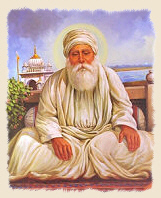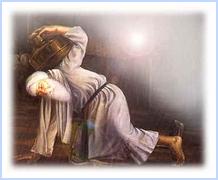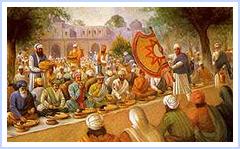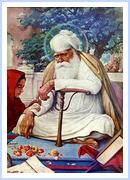Sikhism - Sikh Gurus - Guru Amar Das
Guru Amar Das was born on April 5, 1479 at Basarka village in Amritsar district. He was the eldest son of his parents, Bhai Tej Bhan and Mata Lakhmi. At the age of 24, he was married to Mansa Devi who gave birth to two sons, Mohan and Mohri, and two daughters, Bibi Dani and Bibi Bhani. The early history of Guru Amar Das has been given in the last chapter.

Datu's Animosity
Guru Angad's sons were upset because they claimed that after their father, they were the legitimate heirs to Guruship. Guru Angad's son Datu, therefore, proclaimed himself as Guru in Khadur; but the Sikhs did not accept him as such. Secondly under Guru Amar Das's strict dictum, it was mandatory that all persons, high or low, rich or poor, king or the commoner, Brahmans or Sudras, and Hindus or Muslims, must sit in the same row as equals to dine in the Guru's langar (kitchen). This had upset the Brahmans very much and they were on the search of an opportunity to rectify this situation.
These Brahmans and other higher caste leaders saw some chance in Datu's revolt to capture the Guruship. Upon their support, Datu proceeded to Goindwal where the Guru was stationing.
Guru Amar Das was sitting on his religious throne and was delivering instructions to the congregation. Datu came along with a large number of his companions and kicked the Guru, who fell down the platform. Datu took possession of the platform and proclaimed himself as the Guru. Guru Amar Das got up and said in extreme humility," Sir, pardon me, my hard bones might have hurt your tender feet." After this the Guru left Goindwal and went to his village Basarka. He confined himself in a house outside the town without letting anybody know about his whereabouts.
Datu sat on Guru's throne in Goindwal and was very proud of his position. The Sikhs, however, did not accept him as Guru, and all the pilgrims to Goindwal went away on hearing of the insult to their Guru. On seeing the Sikhs' contempt towards him, one day Datu loaded his newly acquired wealth on a camel and returned to Khadur.
On his way he was encountered with some robbers who seized the camel with the load, and one of the robbers struck Datu on the same foot with which he had kicked the Guru. Datu's foot swelled up and caused him great pain.
The Sikhs were very much distressed at loosing their Guru. They searched all over but could not find him anywhere. Under the leadership of Bhai Buddha, they prayed and then let Guru's mare loose and anxiously followed it for a short distance. The mare made her way to the Guru's house in Basarka, and stood before his door. It was written on the door," Whoever openeth this door is no Sikh of mine, nor I am his Guru." They did not open the door, but made an opening in the wall and made supplication before the Guru. The Guru could not disregard the love and devotion of his Sikhs and returned to Goindwal. The Guru's return was celebrated with illuminations, rejoicing and feasting.
Bawli at Goindwal
Guru Amar Das purchased some land in Goindwal and laid the foundation of a Bawli (a well with descending steps) in 1559. All Sikhs joined in the work of digging the Bawli. There was great activity throughout the construction of the Bawli.

Hari Das, a Khatri of Sodhi tribe, lived with his wife, Daya Kaur, in Chuna Mandi, a suburb of Lahore. Both husband and wife were very religious. After twelve years of their marriage, a son was born to them on September 24, 1534. They called him Ram Das, who was generally known as Jetha meaning first-born. He was very handsome having fair complexion with pleasing personality. As he grew up he liked the company of holy men. One day his mother boiled some pulse, put it into a basket and gave it to him to sell and make profit. Jetha went to the river Ravi. Soon he saw a company of holy men, and Jetha gave the boiled pulse to them and went home. The holy men were very much pleased and prayed for the boy.
One day Jetha saw a company of Sikhs singing the hymns and proceeding with great rejoicing. He asked whither they were going, one of them said," We are going to Goindwal where Guru Amar Das holds his court. Every blessing in this world and the next is obtained by his favor. Come with us." On hearing this Jetha was delighted and he joined them in their pilgrimage.
On seeing the Guru, Jetha's heart was filled with love and devotion. When he made his obeisance to the Guru, he was attracted by his pleasing personality. The Guru remarked," If you have come abandoning all worldly desires, you shall obtain a true sovereignty. Perform work and service." Jetha happily applied himself to the Guru's service. He worked in the kitchen, cleaned dishes, shampooed his Master and brought firewood from the forest. He worked in the excavation of the Bawli during his leisure time.
Guru's eldest daughter, Bibi Dani (also known as Sulakhni) was married to Rama. The other daughter, Bibi Bhani was very religious from the very childhood. When she was of marriageable age, her mother reminded the Guru that it was time to search for a match for her. The Guru ordered the search. When his agent was ready to depart, Bibi Bhani's mother saw a young person standing outside and she said to the agent," Search for a boy like him." The Guru heard her remarks and exclaimed," He is his own parallel, for God had made none other like unto him." The young man thus chosen was Jethaji (Ram Das).
At the time of marriage, the bridegroom was asked by the Guru to choose a gift for himself, as it was customary to do so. Jethaji replied," Sir, bless me with the gift of Hari Nam." Bibi Bhani not only considered the Guru as her father but her Guru also. In the same way she served Jetha not only as her husband but as a saint also. Prithi Chand was their first son and three years later Mahadev, the second son made his appearance. On April 15, 1563 Jetha and Bibi Bhani were blessed with their third son, Arjan, at whose birth there were unusual rejoicing.
Meanwhile the Sikhs continued excavation of the Bawli. After digging very deep they found large stones which hindered the progress. The Guru asked the Sikhs if there was any one who would be courageous to drive a peg into the base to remove the obstruction. He had, however, warned that the operation had great danger because if the person could not avert the gush of the water, he might be drowned. All the Sikhs remained silent and no one came forward to take such a risk. At last Manak Chand of Vairowal, who was married to a niece of the Guru, offered his services. This was the same Manak Chand whose parents were blessed with a son (Manak Chand) by Guru Nanak.
Manak Chand, invoking God's name and through the grace of the Guru, was able to wedge through the stone and the stream of water immediately overflowed the Bawli. He was overtaken by the gush of the water. He almost drowned but by the grace of the Guru, he came to the top from where he was taken out and was revived. Therefore, he was called 'Marjiwra' (revived after death).
The Bawli when finished yielded sweet drinking water. The Sikhs rejoiced at the successful completion of their labor. There were eighty-four steps reaching down the Bawli.
Guru Ka Langar (Free Community Kitchen)
Guru's free kitchen (Guru ka Langar) which was started by Guru Nanak and developed by Guru Angad, was further strengthened by Guru Amar Das. It was the injunction of Guru Amar Das that none would have his audience unless he had first eaten from the Langar. The Guru intended to remove the caste restrictions and prejudices of untouchability. It was, therefore, declared unequivocally that all persons of all castes, high or low, rich or poor, Brahmans or Sudras, Hindus or Muslims, must sit in the same line and eat the same food from Guru's kitchen. When Raja of Haripur or even Akbar, the Mughal Emperor of India, came to see the Guru, they had to sit with common people and dine with them before they could have audience with the Guru. In this way people were lifted above the hypocrisy of caste system and were able to look at one another as brothers and equals.
Emperor Akbar comes to Guru Amar Das
Akbar, the Emperor of India, on his way to Lahore, paid a visit to the Guru at Goindwal. He was informed that he could not see the Guru until he had dined with others from the Guru's kitchen. Akbar partook of the food in the Langar, the more he had it, the more he relished it. After that the Emperor had an interview with the Master. It is said that the Guru rose to receive the Emperor in his arms, but Akbar spontaneously bowed to touch the feet of the Master. The monarch felt a thrill of joy and peace by the holy touch.

Having seen the large number of people fed from the Guru's kitchen, Akbar requested the Guru to accept his services and his offerings. But the Guru replied," I have obtained lands and rent- free tenures from my Creator. Whatever comes daily is spent daily, and for the morrow my trust is in God." Akbar then replied," I see you desire nothing. From thy treasury and thy kitchen countless people receive bounties, and I also entertain similar wishes, I will grant these 84 villages to thy daughter, Bibi Bhani." This was the estate where Guru Ram Das built the city of Ramdaspur which is now called Amritsar.
Abolition of Sati
One day a man, Gobind, came to the Guru and said that if he became victorious in a lawsuit against his relations, he would found a city in honor of the Guru. Fortune favored him and he started to found the city on the bank of the river Beas. He began the work but what was done during the day, was in some mysterious manner undone at night. Gobind came to the Guru and prayed to him to grant him his desire to build the city.

Upon this the Guru sent Baba Amar Das to help him. Babaji prayed to God for His ssistance. The city's work proceeded without any further delay and Baba Amar Das named it Gobindwal and later on it was called Goindwal. Gobind did not forget to build a palace in it for his benefactor Amar Das. When the work was successfully completed, Gobind went to the Guru to offer his thanks and to beg him to come and live in the newly founded city. The Guru did not wish to leave his town, so he ordered Baba Amar as to go and live in Goindwal by night and come to him by day. Babaji obeyed the Guru and settled in Goindwal. In the process of time he took with him all his relations from Basarka and helped them in settling there.
Composition of Anand Sahib
One day a Sidh Jogi came to the Guru and complained that he performed every form of penance but did not obtain any peace of mind. He further showed his desire to abandon his body to be reborn in Guru's family so that he be happy worshipping God and singing His praises. His wish was granted. The Guru had two sons, Mohan and Mohri. Mohri's eldest son was Arth Mal and it is said that this Sidh Jogi was reborn as Mohri's second son. When the Guru heard of the Jogi's rebirth, he sent Bhai Ballu to bring the infant to him.

On seeing the child, the Guru uttered the composition of Anand (Ramkali Mohalla 3, Anand) or the Song of Joy, and called the child, Anand. This composition (Anand Sahib) is now recited on the occasions of marriages and rejoicing.
Selection for Guruship
It should be remembered that Guru's eldest daughter, Bibi Dani was married to Rama who was a zealous Sikh. He used to work in Guru's kitchen and administer to the needs of the pilgrims. Jetha was his younger son-in-law. One day the Guru asked Rama and Jetha,"Each one of you make a platform by the side of Bawli. I will sit on one in the morning and on the other in the evening." When the platforms were completed, the Guru went to inspect them. Rama showed his work and thought that he had done well. The Guru told Rama,"Your platform is not straight, bring it down and rebuild it." Rama dissented but rebuilt another one. It still failed to please the Guru. Rama after long argument, pulled the platform down but refused to build it third time.

The Guru inspected Jetha's platform and said,"Jetha, I do not like it. Demolish it and build another one." Jetha built the second one which was also not of Guru's liking. He demolished it and rebuilt it. The Guru continued to find fault with it until it was destroyed and rebuilt seven times. Jetha then fell at Guru's feet and begged, "I am a fool and lack understanding, while thou possesseth all knowledge. kindly bless me with the wisdom so that I may be able to erect the platform of your liking."
On hearing this the Guru smiled and embraced Jetha and commented," Obeying my order, you have built the platform seven times, so seven generations of thine shall sit on the throne of Guru Nanak."
Bibi Bhani, Guru's youngest daughter, used to attend her father. She used to fan him, draw water and work in the kitchen. One day the Guru was sitting on his couch (chauki) in deep meditation, when Bibi Bhani noticed that one leg of his couch had broken. Fearing that his meditation would be disturbed, she put her arm in place of the broken leg to support the couch. When the Guru opened his eyes, he found blood coming out of Bibi Bhani's arm. On inquiry Bibi explained that broken leg might have caused disturbance in his meditation and so she thought herself fortunate to serve Guru by substituting her arm for the broken leg of the couch. The Guru commented," Whosoever does good work, shall reap the reward thereof." He invited her to ask for any favor. She humbly requested that the Guruship should remain in her family. It is believed that the Guru told Bibi Bhani that the Guruship was not a bed of roses and he warned her of the trouble and torture that the later Gurus would have to go through. Bibi Bhani agreed to embrace all those troubles, and again requested to grant her the wish that the Guruship would remain in her family. So far the Guruship was earned by obedience and devotion to the Guru. Here again Bibi Bhani earned it, for her family, with her devotion and sacrifice. The Guru granted her the wish and the Guruship thereafter remained in Bibi Bhani's family.
Guru Nanak appointed his successor at Kartarpur but asked him to go and live at Khadur. Guru Angad asked his successor, Guru Amar Das to live in Goindwal. Guru Amar Das asked Jetha to search for a place other than Goindwal as a residence for the Sikhs. Jetha found an open land about 25 miles from Goindwal, and he established himself there. He built a house for himself and got a tank excavated which was called Santokhsar. It is also believed that the Guru asked Jetha to excavate another tank towards the east which would be called Amritsar- tank of nectar.
Succession of Guru Ram Das
Guru Amar Das having tested Jethaji in every way, found him perfect and asked for special congregation. Then he asked Bhai Ballu to bring coco-nut and five paise. He asked Jethaji to bathe and clothe in new raiment. Then the Guru descended from his throne and made Jethaji seat on it and called him Guru Ram Das. Bhai Buddha, according to the custom, attached the tilak of Sovereignty to Guru Ram Das's forehead.
Among great rejoicing, all Sikhs made offerings according to their means and saluted Guru Ram Das on his appointment. This ceremony was performed on August 30, 1574 at Goindwal.
Guru Amar Das' Departure
Guru Amar Das proclaimed," God's summons hath come. Let there be no mourning when I have gone, sing God's praises, read God's Word (Gurbani), hear God's Word and obey God's Will." On the first of September, 1574, Guru Amar Das left for his heavenly abode and the spirit blended with the Master Spirit.